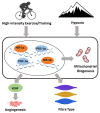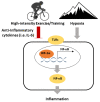The Molecular Adaptive Responses of Skeletal Muscle to High-Intensity Exercise/Training and Hypoxia
- PMID: 32722013
- PMCID: PMC7464156
- DOI: 10.3390/antiox9080656
The Molecular Adaptive Responses of Skeletal Muscle to High-Intensity Exercise/Training and Hypoxia
Abstract
High-intensity exercise/training, especially interval exercise/training, has gained popularity in recent years. Hypoxic training was introduced to elite athletes half a century ago and has recently been adopted by the general public. In the current review, we have summarised the molecular adaptive responses of skeletal muscle to high-intensity exercise/training, focusing on mitochondrial biogenesis, angiogenesis, and muscle fibre composition. The literature suggests that (peroxisome proliferator-activated receptor gamma coactivator 1-alpha) PGC-1α, vascular endothelial growth factor (VEGF), and hypoxia-inducible factor 1-alpha (HIF1-α) might be the main mediators of skeletal muscle adaptations to high-intensity exercises in hypoxia. Exercise is known to be anti-inflammatory, while the effects of hypoxia on inflammatory signalling are more complex. The anti-inflammatory effects of a single session of exercise might result from the release of anti-inflammatory myokines and other cytokines, as well as the downregulation of Toll-like receptor signalling, while training-induced anti-inflammatory effects may be due to reductions in abdominal and visceral fat (which are main sources of pro-inflammatory cytokines). Hypoxia can lead to inflammation, and inflammation can result in tissue hypoxia. However, the hypoxic factor HIF1-α is essential for preventing excessive inflammation. Disease-induced hypoxia is related to an upregulation of inflammatory signalling, but the effects of exercise-induced hypoxia on inflammation are less conclusive. The effects of high-intensity exercise under hypoxia on skeletal muscle molecular adaptations and inflammatory signalling have not been fully explored and are worth investigating in future studies. Understanding these effects will lead to a more comprehensive scientific basis for maximising the benefits of high-intensity exercise.
Keywords: high-intensity exercise; hypoxia; inflammatory signalling; skeletal muscle; training.
Conflict of interest statement
The authors declare no conflict of interest.
Figures


Similar articles
-
Repeated maximal-intensity hypoxic exercise superimposed to hypoxic residence boosts skeletal muscle transcriptional responses in elite team-sport athletes.Acta Physiol (Oxf). 2018 Jan;222(1). doi: 10.1111/apha.12851. Epub 2017 Feb 22. Acta Physiol (Oxf). 2018. PMID: 28103427 Clinical Trial.
-
Effects of systemic hypoxia on human muscular adaptations to resistance exercise training.Physiol Rep. 2014 Jun 6;2(6):e12033. doi: 10.14814/phy2.12033. Print 2014 Jun 1. Physiol Rep. 2014. PMID: 24907297 Free PMC article.
-
How do exercise training variables stimulate processes related to mitochondrial biogenesis in slow and fast trout muscle fibres?Exp Physiol. 2021 Apr;106(4):938-957. doi: 10.1113/EP089231. Epub 2021 Feb 9. Exp Physiol. 2021. PMID: 33512052
-
PGC-1alpha-mediated adaptations in skeletal muscle.Pflugers Arch. 2010 Jun;460(1):153-62. doi: 10.1007/s00424-010-0834-0. Epub 2010 Apr 19. Pflugers Arch. 2010. PMID: 20401754 Review.
-
Adaptation of Skeletal Muscles to Contractile Activity of Varying Duration and Intensity: The Role of PGC-1α.Biochemistry (Mosc). 2018 Jun;83(6):613-628. doi: 10.1134/S0006297918060019. Biochemistry (Mosc). 2018. PMID: 30195320 Review.
Cited by
-
The Acute, Short-, and Long-Term Effects of Endurance Exercise on Skeletal Muscle Transcriptome Profiles.Int J Mol Sci. 2024 Mar 1;25(5):2881. doi: 10.3390/ijms25052881. Int J Mol Sci. 2024. PMID: 38474128 Free PMC article.
-
The Role of Exercise, Diet, and Cytokines in Preventing Obesity and Improving Adipose Tissue.Nutrients. 2021 Apr 25;13(5):1459. doi: 10.3390/nu13051459. Nutrients. 2021. PMID: 33922998 Free PMC article. Review.
-
Influence of Sports Training in Foothills on the Professional Athlete's Immunity.Sports (Basel). 2023 Jan 30;11(2):30. doi: 10.3390/sports11020030. Sports (Basel). 2023. PMID: 36828315 Free PMC article.
-
Cardiorespiratory and metabolic fitness indicators in novice volleyball trainees: effect of 1-week antioxidant supplementation with N-acetyl-cysteine/zinc/vitamin C.J Int Med Res. 2021 Dec;49(12):3000605211067125. doi: 10.1177/03000605211067125. J Int Med Res. 2021. PMID: 34939440 Free PMC article.
-
The Interplay between Oxidative Stress, Exercise, and Pain in Health and Disease: Potential Role of Autonomic Regulation and Epigenetic Mechanisms.Antioxidants (Basel). 2020 Nov 23;9(11):1166. doi: 10.3390/antiox9111166. Antioxidants (Basel). 2020. PMID: 33238564 Free PMC article. Review.
References
-
- Czuba M., Bril G., Ploszczyca K., Piotrowicz Z., Chalimoniuk M., Roczniok R., Zembron-Lacny A., Gerasimuk D., Langfort J. Intermittent Hypoxic Training at Lactate Threshold Intensity Improves Aiming Performance in Well-Trained Biathletes with Little Change of Cardiovascular Variables. BioMed. Res. Int. 2019;2019:1287506. doi: 10.1155/2019/1287506. - DOI - PMC - PubMed
Publication types
Grants and funding
LinkOut - more resources
Full Text Sources
Medical

